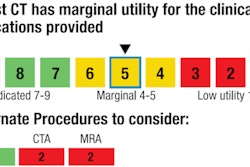PACS industry veteran Oran Muduroglu is hoping lightning strikes a third time with his newest company, Medicalis. Armed with $20 million in new funding, Muduroglu is making workflow management a major part of the company's new focus, with the new direction launched at this month's RSNA show.
Medicalis is banking on a strategy that hits three of the major buttons in imaging informatics: providing decision support for referring physicians, unified workflow management for radiologists working off different PACS and RIS applications, and enterprise scheduling for more efficient use of imaging equipment.
The San Francisco-based company hopes the new approach will appeal to radiologists faced with a changing environment that's forcing them to work more efficiently while reducing the incidence of inappropriate imaging utilization.
Roots in decision support
Medicalis has been known for years as a developer of decision-support and utilization-management software, with its most notable installation at Brigham and Women's Hospital in Boston. The firm originally marketed its software to both providers and payors, but soon found that payors preferred controlling utilization through radiology benefits management (RBM) firms rather than provider-based software applications that gave radiologists more control.
When he came on board as Medicalis chief executive in April 2010, Muduroglu saw the company's technology as an asset that wasn't being exploited. Muduroglu is perhaps best known as co-founder and chief executive of Stentor, a California-based developer of PACS software that was acquired in 2005 by Philips Healthcare of Andover, MA. Prior to that, he was on the management team of Cemax-Icon when it was acquired in 1997 by Imation (which itself was bought by Eastman Kodak, later to become Carestream Health of Rochester, NY).
Muduroglu believed that Medicalis' exclusive focus on utilization management came at the risk of ignoring a burgeoning area of imaging informatics: workflow management, which many radiology practices are turning to in an effort to operate more efficiently.
"When I joined the company, I said we can't just be about utilization. We need to look at productivity, utilization, and quality, as these three things coexist with each other," he said. "And we need to find a business model that works for providers and payors."
Fortunately, Medicalis' work at Brigham and Women's provided a good foundation for the new direction. The hospital for years has been using Medicalis decision-support software based on appropriateness criteria to guide referring physicians into making wiser choices when ordering imaging studies. In addition to Brigham, the software is widely used in Minnesota, where some 80% of the fee-for-service outpatient imaging studies in the state are processed through the application.
As the Brigham installation evolved over time, it also included the development of productivity software, such as a tool that's able to look at the dozen different RIS applications installed at the facility and its affliated institutions, taking a "federated" view of all the data and allowing radiologists to protocol studies as they come in.
Another tool developed was enterprise scheduling, a natural outgrowth of the computerized physician order entry (CPOE) that's required by decision-support software -- if doctors are placing orders electronically, it makes no sense to force them to pick up the phone to schedule time on a scanner, Muduroglu said. Now, some 4,500 physicians in the Massachusetts area are scheduling patients simultaneously when placing orders for studies.
RadWorkFlow acquisition
The evolution of the new Medicalis became complete in July 2010, when the company acquired rights to the RadWorkFlow software developed by Inland Imaging, a large radiology group in the western U.S. that had developed the application for workflow management and critical results reporting across its own facilities.
Medicalis integrated RadWorkFlow with the technology developed at Brigham and Women's, enabling the company to now offer an integrated workflow management package that includes decision support, enterprise scheduling, and other features. What's more, the software works across sites with PACS and RIS applications from multiple vendors.
Medicalis rolled out the new concept at this month's RSNA conference as Collaborative Workflow Solutions. The strategy has three main components:
- Professional solutions, designed to improve radiologist productivity through a workflow platform that connects multiple PACS, RIS, and electronic health records into a single platform
- Operational solutions, which cover the ordering and scheduling of imaging exams to improve productivity of devices such as scanners, and include business analytics tools
- Utilization solutions, which include the company's clinical decision-support activities, designed to ensure appropriate imaging utilization
The components are modular, and Medicalis can offer customized packages to meet the needs of customer sites, Muduroglu said. For example, a large radiology group might be more interested in the company's professional solutions, while an imaging center operator might be looking more for the scheduling benefits offered by the operational solutions.
The firm is beginning to make commercial shipments of the professional and operational components; the company's utilization solutions, based on the older decision-support approach, are already available.
Discontinuous change
Muduroglu sees recent trends in radiology as working to the company's favor. Radiology groups are merging and becoming larger, creating challenges in managing workflow across different geographic locations and between different flavors of RIS and PACS software. These practices need a single unifying layer to link them together -- especially considering data indicating that radiologist productivity declines as groups become larger than 15 to 20 radiologists, Muduroglu said.
Other trends are contributing to an environment that Muduroglu calls discontinuous change: utilization is going down, reimbursement is falling, competition is growing, and the specialty's very business model is changing. How can radiology providers win in this environment?
"You've got to win by productivity and quality to differentiate yourself from your competitors," he said. "Times are changing in radiology. The problems we are trying to solve now are not the problems of the past, and this requires a whole different approach to workflow that is really all about quality, productivity, and utilization."
By Brian Casey
AuntMinnie.com staff writer
December 15, 2010
Related Reading
Medicalis upgrades productivity software, November 23, 2010
Medicalis acquires workflow software, November 5, 2010
Medicalis launches clinical decision-support platform, June 9, 2010
Medicalis signs Muduroglu as CEO, April 15, 2010
GE partners with Medicalis, July 15, 2009
Copyright © 2010 AuntMinnie.com



















